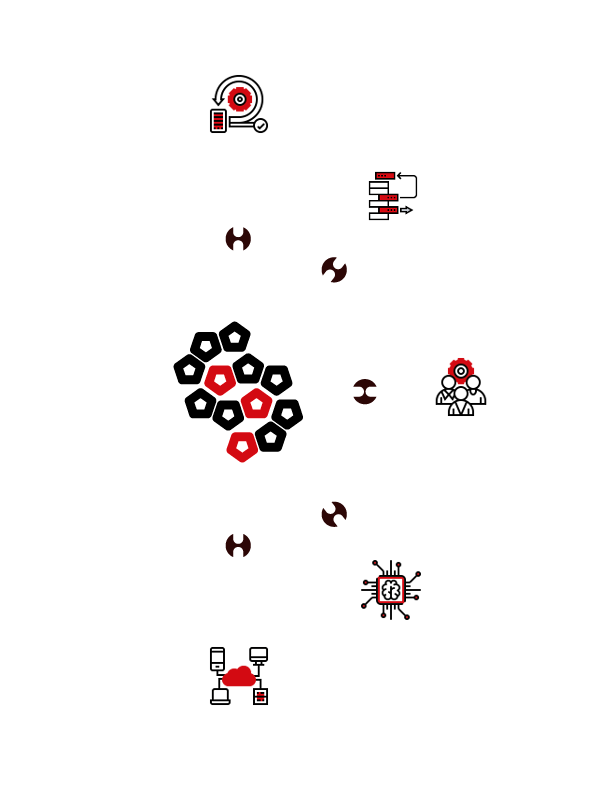¿Necesitas ayuda para tu proyecto de transformación digital?
Ponemos a tu disposición nuestro equipo altamente capacitado aplicando las mejores prácticas en gestión de proyectos ágiles.
Descubre nuestro amplio portafolio de servicios personalizados a su medida

Corcaribe Tecnología
conectamos ideas
¿Crees que la tecnología es un gasto y no una inversión? Te ayudamos para que puedas aprovechar al máximo lo que has invertido en tecnología, poner en marchas tus ideas y resolver los problemas con proyectos atascados.
Corcaribe Tecnología C.A. apoya a las organizaciones y emprendedores en el desarrollo de sus ideas, aplicando marcos de trabajo ágiles y estrategias de integración de sistemas con tecnologías OpenSource.
Contamos con profesionales certificados en diversas áreas, con gran experiencia en el mundo de la tecnología y la enseñanza, dispuestos a escucharte y ayudarte a alcanzar tus metas.
Somos Centro Autorizado Scrum Manager y parte de la red de Aliados de CertJoin. Explora nuestra oferta de certificaciones Agile/Scrum y de otras áreas como ISO/IEC27001, Data Science, Marketing Digital y más.
Mira nuestro portafolio de servicios para ver si te podemos ayudar
Portales Web/eCommerce
Diseño, Implementación y Optimización de sitios Web Corporativos y sistemas eCommerce. Trabajamos con herramientas Open Source líderes en el mercado como WordPress y Prestashop.
Asesoría y Capacitación
Servicios de Asesorías, Capacitación y Certificación en áreas especializadas de Gestión de Proyectos Ágiles, áreas técnicas de Tecnologías de la Información, Gerencia de Proyectos y Marketing Digital
Sistemas ERP/CRM/BI
Implementación de sistemas ERP/CRM con Odoo. Además tenemos experiencia en proyectos de Business Intelligence, Data Mining, Inteligencia Artificial para medianas y grandes empresas
Infraestructura TI
Servidores, Redes de Datos, Seguridad Informática, Administración de Bases de Datos SQL, Almacenamiento, Replicación, Respaldos y Recuperación de Datos, Centros de Datos, Servicios Cloud y más.
Sistemas eLearning
Diseño e implementación de soluciones eLearning para escuelas, universidades, academias corporativas con Moodle y WordPress, Udemy, Classroom, Edmodo. Diseños de contenidos educativos.
Aplicaciones Móviles
Diseñamos e implementamos aplicaciones móviles multiplataforma Android/iOS
Marketing Digital
Servicio de Community Manager y Trafficker Digital. Optimización de perfiles de redes sociales, campañas de Google y Facebook Ads, email Marketing, Copywriting, Mercado Libre, Páginas Amarillas y más
¿No consigues lo que buscas?
Pregunta y si podemos hacerlo con seguridad te haremos una propuesta ajustada a tus necesidades
3 razones por las cuáles
debería elegirnos
Conocimiento
Contamos con un equipo Multidisciplinario de Profesores Universitarios y Jóvenes Profesionales que conjugan su experiencia, creatividad y aprendizaje acelerado de tecnologías para el cambio y la mejora de nuestros servicios.
Mejores Prácticas
Creemos en la Agilidad y nos esforzamos por investigar, adaptar y aplicar las recomendaciones y mejores prácticas. Hemos puesto a prueba nuestras habilidades y capacidades en proyectos de gran envergadura.
Servicio
Aliviamos los dolores de cabeza de nuestros clientes en materia de tecnologías y comportamiento organizacional para apoyar la mejora continua de las operaciones
Socios Comerciales
Hemos desarrollado la capacidad de ponernos en el lugar de los clientes y ver cuales son sus problemas y dolores de cabeza, esto nos ha permitido convertirnos en aliados fomentando relaciones ganar-ganar. Aquí están algunas de las empresas que creyeron en nosotros:















Mira lo que dicen de nosotros
Nos conocimos a través de Promaxima buscando desbloquear la cuenta de Instagram, a partir de allí ha quedado una buena relación apoyandonos a definir la estrategia publicitaria de Facebook/Instagram, Google Ads con resultados positivos. La alianza ha sido muy educativa, hemos aprendido mucho. Esperamos continuar esta relación y seguir avanzando
Angelo Freites
Queremos agradecer a Corcaribe por el trabajo de integración y desarrollo que se hizo posible que nuestra empresa SOi Materiales Eléctricos tuviera presencia en la Web para avanzar en la economía Digital. Contamos con asesoría personalizada y se han concretando buenas ventas a través del ecommerce y seguimos en el proceso de mejora continua del sitio web. Recomendados
José Angel Alvarez
Mi experiencia con Corcaribe ha sido excelente. Todos los muchachos son jóvenes venezolanos muy bien preparados en el área de tecnología y marketing. Su calidad de trabajo y ética laboral es única. Recomendados, top
AIda Ibarra
Gracias al apoyo tecnológico y de marketing digital de Corcaribe hemos podido tener un mayor alcance en la promoción de las actividades relacionadas a la formación de Campeones para la vida y a la difusión del Ajedrez. Sumamente complacidos y recomendados. Muchos éxitos y bendiciones para todas aquellas personas y organizaciones que nos han apoyado desde el principio
Dionisio Lopez
¿Tienes dudas?
Preguntas Frecuentes
Revisa nuestra lista de preguntas y respuestas más frecuentes que nos consultan nuestros clientes, de no conseguir ninguna que responda su inquietud, por favor envíanos un mensaje que gustosamente le atenderemos.
La mayoría de las Pymes se enfocan en el área operativa y si tienen un crecimiento no previsto pudieran tener problemas con la integración de sistemas y la gestión de la demanda de servicios, cumplimientos de plazos de entrega, retrabajo, errores manuales, falta de control sobre las actividades, problemas de comunicación, entre otros.
Para minimizar los efectos de los problemas antes mencionados ofrecemos soluciones Tecnológicas y Capacitación. Desarrollamos Portales Web Empresariales, Sistemas de Comercio Electrónico, Sistemas Administrativos para la gestión de Inventario, Nómina, Contabilidad, Finanzas, Comunicaciones. También ofrecemos Integración de Sistemas, Gestión de Plataforma Tecnológica y Asesoría en gestión de Proyectos.
También ofrecemos certificaciones que permitan a los empleados desarrollar nuevas capacidades para identificar y resolver problemas y escalar la agilidad a toda la organización. Ofrecemos acompañamiento en este proceso para guiarlos en los primeros pasos.
Para la Gran Industria tenemos soluciones de Inteligencia de Negocios, Minería de Datos y Sistemas de apoyo a la toma de decisiones, basados en gestión de procesos.
Además ofrecemos servicios de infraestructura tecnológica como Diseño, Implementación y Aseguramiento de Redes de Datos, Sistemas de Almacenamiento Masivo de Datos, Portales Web con Intranet y Flujos de Trabajo
También ofrecemos cursos certificados para que sus equipos de trabajo lleven las operaciones a un nivel superior y cumplir con los estándares y mejores prácticas. Si lo requiere podemos acompañarles en el proceso para garantizar el éxito de los proyectos y metas planteados
Para los microempresarios y emprendedores tenemos servicios de apoyo y capacitación en Presencia Digital, Planificación de Proyectos, Marketing Digital, Formulación de Casos de Negocio con Canvas, Portales Web, entre otras cosas.
Podemos apoyarte a dar el salto de Emprendedor a Empresario, llevar tu negocio a otro nivel.
Tenemos cursos para tí y un equipo dispuesto a escucharte y ayudarte a alcanzar tus metas.
¡Queremos que también tengas un caso de éxito!
En Corcaribe conectamos ideas. ¿Qué esperas?






